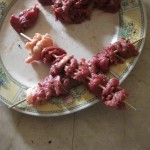My 2 boys have been handed to me by my wife for clearing their itchy eczematic legs. Putting them on a raw paleo diet. Started their regimen with egg yolk liver flushes. Came up with 1 raw duck egg plus 1/4 cup of freshly squeezed calamansi juice plus 1 tablespoon of Anchor butter (unsalted). Drank the concoction first thing in the morning.
Eventual results were:
– My 7 year old boy was stinky farting
– 7 yr old boy finally did his poop and said his poop stinked, kid this age has liver garbage.
– 9 yr old boy also pooped and smelled the liver bad smell he reports, he’s done liver flushing before.
Getting them adjusted to raw meats again. Searing their barbecues 5 seconds each side. Tomorrow barbecues get seared 4 seconds each side, then down to 3, then 2, then 1, then none.
7 yr old boy is less adjusted to raw meat than my 9 yr old who once did 2 months straight raw paleo diet.
Have to be firm and teach them about raw paleo diet. They need to know this life skill. Told them the goal was to be itch free in their legs. Eczema free in their legs. Their mom has given up on her other “methods”. Raw paleo diet will do it.
Another egg yolk liver flush for them scheduled this morning. This time I will use virgin coconut oil instead of butter. Hopefully there will be less complaints.
In the afternoon kidney cleansing with avocado leaves tea.
** Update **
The 2 boys say their itching on their legs have drastically been reduced.
We are on the right track.
So it seems cooked food pollutes these boys’ livers.





